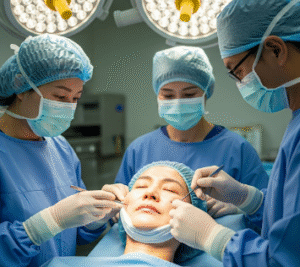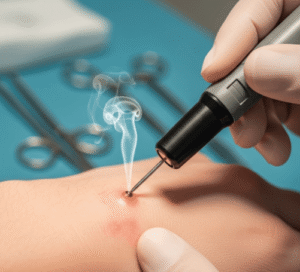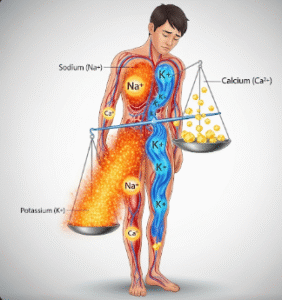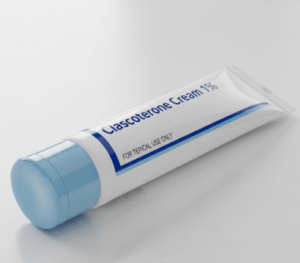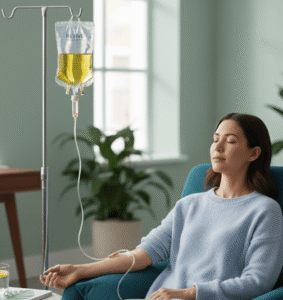What It Is
Fleur-de-lis abdominoplasty is a specialized type of tummy tuck designed for patients who have significant excess skin and tissue in both the vertical and horizontal directions of the abdomen. Unlike a standard abdominoplasty, which primarily removes skin and fat in the lower abdomen, this technique adds a vertical incision, allowing for removal of skin from side to side as well.
The name “fleur-de-lis” comes from the shape of the incisions, which resemble the French lily symbol. The result is a flatter, tighter, and more contoured abdomen, often after massive weight loss or bariatric surgery. In Korea, this surgery is performed in advanced plastic and reconstructive surgery centers that specialize in post-weight-loss body contouring.
Why It’s Done
Fleur-de-lis abdominoplasty is typically recommended for patients who:
- Have large amounts of loose, hanging abdominal skin after major weight loss.
- Experience skin irritation, infections, or hygiene problems due to excess folds.
- Want improved clothing fit and appearance.
- Desire better core strength and abdominal wall function after stretched skin and muscles.
- Seek comprehensive contouring beyond what a standard tummy tuck can achieve.
Alternatives
Depending on the patient’s needs, alternatives may include:
- Standard abdominoplasty: Suitable for moderate skin excess mainly in the lower abdomen.
- Extended abdominoplasty: Addresses loose skin that extends to the flanks and hips.
- Mini-abdominoplasty: Removes only small amounts of skin and tightens the lower abdomen.
- Non-surgical options: Skin tightening with radiofrequency or ultrasound devices, though results are limited for large excess skin.
Preparation
Preparation is an essential step to ensure safety and optimal results. It typically includes:
- Consultation: Detailed discussion with a plastic surgeon, including medical history and weight stability.
- Physical examination: To assess skin laxity, abdominal wall condition, and general health.
- Pre-operative tests: Blood work and imaging if necessary.
- Lifestyle adjustments: Patients are advised to stop smoking and avoid alcohol several weeks before surgery to promote healing.
- Medication review: Temporary discontinuation of blood thinners or other medications that increase bleeding risk.
- Recovery planning: Arranging time off work and home assistance for the early recovery period.
How It’s Done
Fleur-de-lis abdominoplasty is performed under general anesthesia and usually takes 3–5 hours. The procedure involves:
- Incision placement: A horizontal incision across the lower abdomen (hip to hip) and a vertical incision from the breastbone to the pubic area.
- Skin and fat removal: Excess tissue is carefully excised in both directions.
- Muscle tightening: If needed, weakened or separated abdominal muscles are sutured for a firmer abdominal wall.
- Redraping the skin: The remaining skin is pulled tight for a smooth contour.
- Umbilicus repositioning: The belly button is repositioned to a natural location.
- Closure: The incisions are closed with sutures, and drains may be placed to reduce fluid buildup.
Recovery
Recovery after fleur-de-lis abdominoplasty requires patience and careful aftercare.
- First week: Pain, swelling, and tightness are common. Patients typically stay in the hospital for 1–2 days.
- Compression garments: Worn continuously to reduce swelling and support healing.
- Activity: Light walking is encouraged soon after surgery, but strenuous activity should be avoided for 6–8 weeks.
- Scarring: The procedure leaves an anchor-shaped scar, which typically fades with time and can be managed with scar treatments.
- Final results: Visible within weeks, but full healing and final contour improvements may take 6–12 months.
Possible Complications
Like all major surgeries, this procedure carries risks, including:
- Infection or bleeding.
- Delayed wound healing, especially at the intersection of incisions.
- Seroma (fluid accumulation).
- Blood clots or deep vein thrombosis (DVT).
- Numbness or changes in abdominal skin sensation.
- Noticeable scarring, though usually treatable with medical therapies.
Treatment Options in Korea
Diagnosis
- Comprehensive consultation and body contouring evaluation.
- Use of body composition analysis and 3D imaging to plan surgery.
Medical Treatments
- Pre- and post-operative medications for pain relief, infection prevention, and swelling control.
- Advanced wound care methods to support healing and minimize complications.
Surgical or Advanced Therapies
- Standard fleur-de-lis abdominoplasty: For patients with extensive skin redundancy.
- Extended body lift combination: May be combined with flank or thigh lifts for patients with massive weight loss.
- Liposuction-assisted tummy tuck: Combines fat removal with skin excision for improved contour.
Rehabilitation and Support
- Post-operative monitoring and wound care management.
- Scar management with silicone sheets, laser therapy, or injections.
- Lymphatic drainage massages to reduce swelling.
- International patient services, including translators, hospital coordinators, and virtual follow-ups after returning home.



